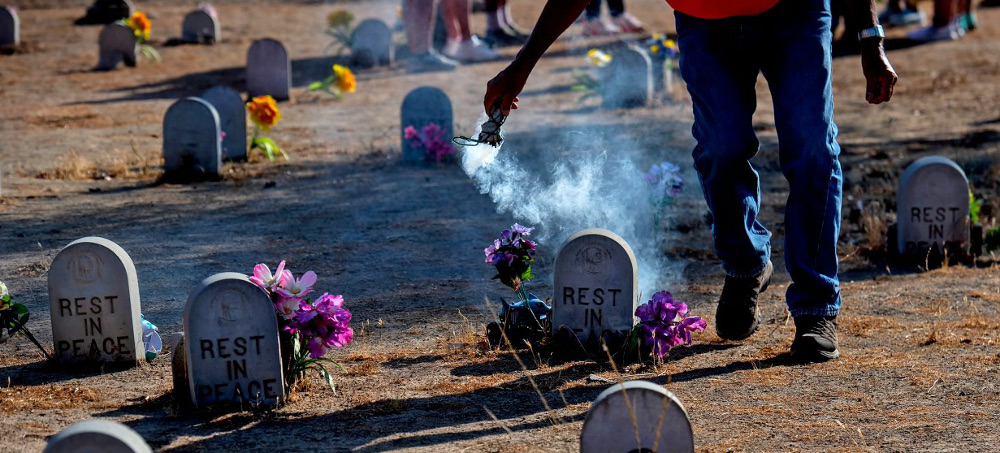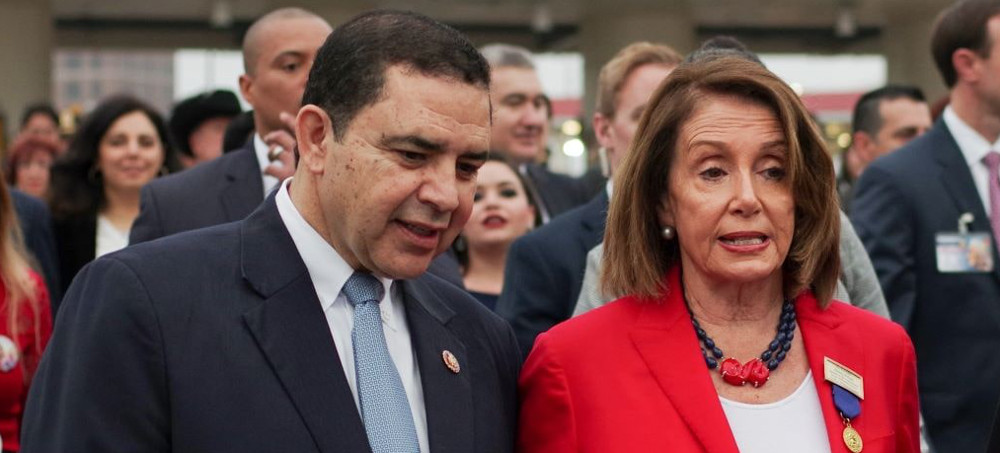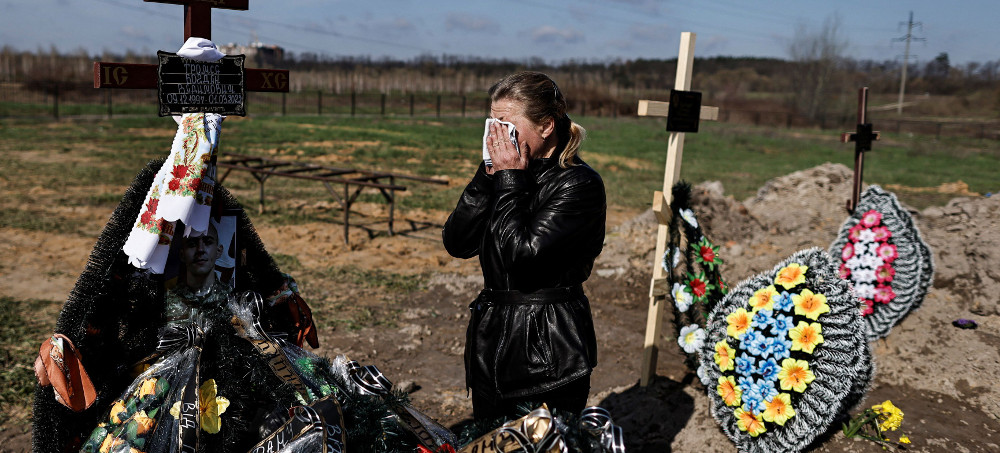Live on the homepage now!
Reader Supported News
Alito’s draft decision not only rolls back women’s right to control their bodies, it also calls into question the right to privacy and other precedents.
This arbitrary opinion in the case of Dobbs v. Jackson Women’s Health Organization, part of the brazen effort of reactionary judges to roll back decades of progress toward a more perfect union, scorns the will of the vast majority of Americans.
That the Supreme Court now convenes huddled behind concrete bunkers and unscalable metal fences is testament to the fury that this judicial wilding has already sparked.
The parallels to the Court’s Dred Scott decision in 1857 are chilling. In Dred Scott, a politicized court, in an opinion written by Chief Justice Roger Taney, ruled that African Americans were not citizens under the Constitution and therefore had no rights that a white man need respect, or that the federal government could protect. The decision contributed directly to the political divisions that culminated in the Civil War.
As with Alito’s draft, the Dred Scott decision was leaked ahead of time. As with Alito’s opinion, it was preceded by a disingenuous campaign to urge citizens to respect the decisions of the court as grounded in law, not politics.
In Dred Scott, Taney relied on a rigid standard of interpretation that ignored precedent and opinion. He argued that Black people could not be American citizens because at the time of the founding they were considered “beings of an inferior order ... and so far inferior, that they had no rights which the white man was bound to respect, and that the negro might justly and lawfully be reduced to slavery for his benefit.”
In Dobbs, Alito similarly adopts a rigid standard, arguing that the Constitution contains no words about abortion and that abortion was widely outlawed at the time of the founding. Of course, at the founding, women were not citizens, didn’t have the right to vote, and were treated largely as property of their husbands.
The Dred Scott decision left the question of slavery not to the national majority, which sought to outlaw it in western lands, but to state legislatures that reserved voting to white men. Alito’s decision reverses a settled national precedent, supported by the majority, and leaves the question to state legislatures, most of which remain dominated by white men.
In Dred Scott, Taney reviewed the laws of the original American states, distorting and ignoring actual history to make his case. Alito reviews the laws of the states, and distorts and ignores history to bolster his opinion.
Taney believed that the decision would help temper the growing controversy over slavery that was dividing the nation. Alito suggests that overturning Roe will help reduce political divisions. Both were disastrously deluded.
Perhaps the greatest difference between Taney’s opinion in Dred Scott and Alito’s opinion in Dobbs is that Alito’s opinion is even more lawless and more brazen. He is overturning a precedent of 50 years that at least three judges in the majority agreed was “settled law” when they testified under oath in their confirmation hearings.
Moreover, the justices making up the majority are clearly partisans representing a zealous minority. Three were nominated by Donald Trump, who lost the popular vote in 2016 and 2020, and tried to overturn the 2020 result. Two were nominated by George W. Bush, who also lost the popular vote in his first term.
The Taney decision was directed at slavery. Alito’s decision not only rolls back women’s right to control their bodies, it also calls into question the right to privacy, and the precedents that have protected the right to marry whomever you choose, to use contraception, to have privacy in your home, to not be discriminated against on the basis of sexual preference and more.
After the Dred Scott decision, the great Black abolitionist Frederick Douglass denounced Taney’s reasoning as contrary to both the Constitution and the vision of the founders. He argued the decision would not stand: “I have no fear that the National Conscience will be put to sleep by such an open, glaring and scandalous tissue of lies.”
Similarly, Alito’s opinion, assuming it becomes the decision of the court, will spark fierce political battles. But it, too, will not stand, but be remembered only as a mark of ignominy.
We are not calling people to quietness, which is the absence of noise. Peace is the presence of justice. We must have mass action, litigation, legislation and registration. It’s not too late.
 Sen. Joe Manchin says he'll block an abortion rights law. (photo: Getty)
Sen. Joe Manchin says he'll block an abortion rights law. (photo: Getty)
The Democratic legislation to enshrine abortion rights into federal law looks set to fail in the Senate this afternoon by a vote of 49-51, after the West Virginia senator Joe Manchin said he would cross the aisle and join Republicans to vote no.
“I would vote for a Roe v Wade codification if it was today. I was hopeful for that, but I found out yesterday in caucus that wasn’t going to be,” he said.
The legislation would codify the 1973 Roe v Wade ruling that gave constitutional protection to abortion rights and, crucially, prevent states from acting to remove or alter those protections in the future.
Manchin also voted against the women’s health protection act of 2021 earlier this year, so his opposition is not entirely surprising.
The bill was already expected to fail today because Democrats do not have the 60 votes necessary to overcome a Republican filibuster. With Manchin’s opposition, the final vote to invoke cloture on the bill will likely be 49 to 51, with all Republicans voting against the measure.
Republican senators Susan Collins and Lisa Murkowski have said they would support codifying Roe, but they do not support the women’s health protection act because they consider it too expansive.
Tammy Baldwin, Democratic senator for Wisconsin and co-sponsor of the legislation, said Manchin was wrong.
“I think his interpretation of the bill is incorrect when he says it goes a lot further,” Baldwin told CNN.
“Actually, it keeps the states from interfering with Roe v Wade and restricting access.
“That’s the additional provisions of the women’s health protection act, and they need to be there because you look how many states have taken an action like the Texas law that allows vigilantes to go out and and try to find anybody who aided or abetted abortion.”
 Dan Romero, or Walking Bird, of the Ute Indian Tribe, cleanses children's graves with sage at Sherman Indian School Cemetery in Riverside, Calif., on July 18, 2021. (photo: Cindy Yamanaka/Getty)
Dan Romero, or Walking Bird, of the Ute Indian Tribe, cleanses children's graves with sage at Sherman Indian School Cemetery in Riverside, Calif., on July 18, 2021. (photo: Cindy Yamanaka/Getty)
The Interior Department documented more than 500 deaths of Indigenous children, but it's far from a complete count. "We have a long way to go," one expert said.
The report is the first time in U.S. history that the government has attempted to comprehensively research and acknowledge the magnitude of the horrors it inflicted on Native American children for decades. But it falls well short of some independent estimates of deaths and does not address how the children died or who was responsible. The report also sheds little new light on the physical and sexual abuse generations of Indigenous children endured at the schools.
The report and an accompanying news release acknowledge the harms to Indigenous children but stop short of offering an apology from the federal government, which tribal leaders have been requesting for decades. Last month, Pope Francis apologized for the Catholic Church’s role in Canada’s boarding school system, and First Nation leaders there are asking him to apologize in person when he visits the country this summer.
Interior Secretary Deb Haaland said in Wednesday’s news release: “The consequences of federal Indian boarding school policies — including the intergenerational trauma caused by the family separation and cultural eradication inflicted upon generations of children as young as 4 years old — are heartbreaking and undeniable. We continue to see the evidence of this attempt to forcibly assimilate Indigenous people in the disparities that communities face.”
The report identified more than 500 child deaths after examining records for 19 of the facilities, a small share of the total number of schools identified. “As the investigation continues, the Department expects the number of recorded deaths to increase,” it states. The number is significantly less than some estimates, which are in the tens of thousands.
“The United States doesn’t even know how many Indian students went through these institutions — let alone how many actually died in them,” said Preston S. McBride, an Indian boarding school historian and a Comanche descendent. McBride has found more than 1,000 student deaths at the four former boarding schools he has studied, and estimates the overall number of deaths could be as high as 40,000.
“Basically every school had a cemetery,” he said. “There are deaths at or deaths because of virtually every single boarding school.”
Those deaths were the result of everything from illness to abuse, McBride said, based on his review of historical records, including letters written by students, parents and administrators. Getting to the true number would take a significant amount of time and research, McBride said. “I think we have a long way to go.”
The Interior Department’s investigation located 53 gravesites across the country — a number that is also expected to increase — but did not name the schools to prevent “well-documented grave-robbing, vandalism, and other disturbances to Indian burial sites.”
Haaland, a citizen of the Laguna Pueblo and the first Native American to lead the department, announced the investigation last June. It is intended to provide a basis for how the U.S. government will reckon with its troubling history by researching and locating potential gravesites, repatriating children’s remains and offering resources and access to the affected Indigenous communities to address the ongoing impact of the boarding schools.
Beginning in the early 1800s, the U.S. government stole Native American children from their communities and forced them to attend Indian boarding schools, where they were stripped of their languages and traditions, given English names and trained to perform military drills.
The report found 408 schools in 37 states that were established from 1801 to 1969 and received funding or other forms of support from the federal government. Half of them also received support from religious institutions or organizations, “including funding, infrastructure, and personnel,” the report found. Many of the religious institutions were also paid by the government for each Indigenous child they placed in the boarding school system.
The report found that the U.S. government “targeted” Indigenous children as part of its efforts to assimilate them and dispossess their tribal nations of land, and it lays out the history of that method, developed largely by Thomas Jefferson. While the history may be new to many Americans, it is familiar to many in Indian Country. Survivors and their families have documented countless examples of systemic abuse and generational trauma, as some of the schools remained open into the 1990s.
The report, which is intended to be a first step, includes a recommendation for a continuing investigation and additional funding. Other recommendations include creating a repository for the information gathered from federal agencies and private institutions and providing more funding for the Native American Graves Protection and Repatriation Act, the federal law that regulates the repatriation of Indigenous remains.
While the report acknowledges an era of violence perpetrated on Native American children, it does not ensure that the government will take any immediate steps to address the devastation left by its policies. The report notes that the federal government has never provided a forum for survivors or their descendants to voluntarily detail their experiences.
In Canada, following the establishment of a truth and reconciliation commission, the government recently set aside $4.7 billion to support Indigenous communities affected by its residential schools. The U.S. has no similar commission — or funding.
Two measures before Congress could change that. Bills by Sen. Elizabeth Warren, D-Mass., and Rep. Sharice Davids, D-Kan., a citizen of the Ho-Chunk Nation, would create a truth and reconciliation commission on Indian boarding schools, offering a framework for how the government responds to the tribal nations and citizens its policies have negatively affected.
The House Natural Resources Committee will hold a hearing on the legislation Thursday, and boarding school survivors can submit testimony about their experiences until May 26.
Even if the measures pass, they would still leave open legal loopholes that limit the government’s ability to investigate the history of boarding schools, including an exemption that allows some religious organizations to opt out. The Native American Graves Protection and Repatriation Act applies only to land that is under federal control or institutions that receive federal funding. The government has little control over gravesites on private land and records held by private organizations — like the Catholic Church, which operated several Indian boarding schools.
The report does not address that issue, but it does recommend that the second phase of the investigation compile a list of organizations that supported and benefited from the Indian boarding school system. And it recommends consultation with tribes for the reclamation and co-management of burial sites. Still, the recommendations do not include a clear path to action.
 No matter how much of a liability antiabortion congressman Henry Cuellar becomes, establishment Democrats seem determined to stick with him. (photo: Matthew Busch/Getty)
No matter how much of a liability antiabortion congressman Henry Cuellar becomes, establishment Democrats seem determined to stick with him. (photo: Matthew Busch/Getty)
Even in the wake of news that Roe v. Wade may be overturned, the Democratic leadership is backing right-wing Texas representative Henry Cuellar against his primary opponent, Jessica Cisneros, a Berniecrat who favors abortion rights.
Cuellar faces a primary challenge from Jessica Cisneros, a twenty-eight-year-old left-wing Democrat and human rights lawyer who has been endorsed by Bernie Sanders, Justice Democrats, and AOC. The March 1 primary was so close — he came out ahead by a point and a half — that Cisneros and Cuellar are heading into a runoff on May 24.
Pelosi is not alone in this madness. No matter how much of a liability Cuellar becomes, establishment Democrats seem determined to stick with him. House majority whip Jim Clyburn, too, travelled to South Texas’s Twenty-Eighth Congressional District to appear at a rally for Cuellar the day after the news about the Supreme Court leaked to Politico, and dismissed the idea that Democrats should not support an abortion opponent right now as “pretty sophomoric.” House majority leader Steny Hoyer, too, has been sticking by Cuellar. The American Prospect reports that at least three Democratic Congressional Campaign Committee–approved consulting firms are working on helping Cuellar against Cisneros.
Democratic leadership’s continued support for Cuellar is appalling, as it suggests that it doesn’t understand the urgency of the abortion fight — nor any of the other pressing issues of our time, for that matter.
There are times when it may be justified to support an antiabortion candidate who’s progressive on other issues that are matters of life and death for women and the working class. There aren’t many examples of this, but it happens: the late Senator Harris Wofford, for example, a liberal Democrat and Catholic convert (who married his much younger male lover at the age of ninety), waffled on abortion but famously won a tough general election fight in heavily Catholic Pennsylvania in 1991 by advocating single-payer health care, and championed that idea throughout his career.
But with the Right spoiling for a civil war to maintain traditional gender hierarchies — and making alarming progress — these are not ordinary times, and supporting an antiabortion Congressional candidate against a progressive challenger is tone-deaf and politically suicidal for the Democrats this year. Cuellar received an award in January for his antiabortion efforts. And he’d earned it: last year, Cuellar voted against a House bill that would have made the right to abortion the law of the land. (It later failed in the Senate.) He was the only Democrat to do so. The Democrats have been vowing to fight for abortion rights – even fundraising off such promises all week — but to meaningfully defend the right to choose, they need unity in Congress.
Not only is this a high-stakes moment for women’s reproductive rights, but Henry Cuellar is also no Harris Wofford. An FBI raid on his home in January, over his business ties in Azerbaijan, has cast doubts about his honesty and, of course, about his electability in November. Politically, it is hard to distinguish him from a Republican. He supported Rick Perry for energy secretary in 2017. He has been called “Big Oil’s favorite Democrat” and frequently votes with Republicans on energy and climate issues, even voting against protecting the Arctic oil refuge in 2019. He’s such a loyal towel boy of the fossil fuel industry that the American Petroleum Institute spent $1.3 million on his 2020 reelection campaign, and Republican colleagues who also depend on fossil fuel money have been donating heavily to help him survive Cisneros’s challenge this year. In 2020, he became the first Democrat ever to win the Koch network’s endorsement. He voted against the PRO Act, which would make it much easier for workers to organize unions, galvanizing an unusual number of Texas unions to campaign against him in this primary. (Unions usually back Democratic incumbents, but unlike the Democratic leadership, they do have issues that are important to them.)
Pelosi’s support for Cuellar might be understandable if he didn’t have a great primary opponent. But Jessica Cisneros is exactly the kind of person Nancy Pelosi should be trying to bring to Congress. She is a young, impassioned first-generation Mexican American whose parents were farmworkers. In addition to reproductive rights, her platform includes Medicare for All, a $15 minimum wage, immigration reform, and the Green New Deal. She has been highlighting her opponents’ coziness with corporate interests, contrasting his lifestyle of riding with donors on private jets with the struggles of his working-class constituents.
It’s an awkward time for the party leadership to make clear that keeping Berniecrats out of Congress is more important to them than women’s reproductive freedom and lives.
Cisneros has been — especially over the past week — campaigning aggressively on Cuellar’s abortion opposition, as she should. NARAL Pro-Choice America is running ads in the district supporting her. It’s not too late for the Democratic Party leadership to ditch Cuellar and join the pro-choice movement. Many observers expect the abortion issue to help Cisneros by motivating voters who are angry at the prospect of losing abortion rights.
Joe Biden said on Tuesday that it will “fall to voters to elect pro-choice officials this November.” Someone should let the president know that his own party’s leadership is doing its best to ensure voters in South Texas won’t have such choices.
 A woman mourns by her son's grave at a cemetery in Bucha, Ukraine, last month. (photo: Zohra Bensemra/Reuters)
A woman mourns by her son's grave at a cemetery in Bucha, Ukraine, last month. (photo: Zohra Bensemra/Reuters)
The prosecutor’s statement accused Vadim Shishimarin of firing several shots with a Kalashnikov rifle from a car, killing an unarmed 62-year-old resident in a village in the Sumy region of northeastern Ukraine on Feb. 28. It said the victim was pushing a bike by the side of a road before he was shot in the head and “died on the spot a few dozen meters from his home.”
The prosecutor’s office said Ukrainian investigators collected “evidence of his involvement in violation of the laws and customs of war combined with premeditated murder” and that the crime can carry a penalty of 10 to 15 years or life in prison. The statement did not provide details on the nature of the evidence or how the Russian soldier ended up in Ukrainian custody.
“Shishimarin is actually physically in Ukraine,” Iryna Venediktova, the prosecutor general, told Ukraine’s public broadcaster. “We are starting a trial not in absentia, but rather directly with the person who killed a civilian, and this is a war crime.”
Ukrainian authorities have pushed ahead with efforts to investigate alleged war crimes by Russian forces across the country, even as holding senior officials of a world power to account faces big hurdles and Kyiv has acknowledged it may be difficult to bring perpetrators to justice during a raging war.
Last month, prosecutors filed their first charges, in absentia, to Ukrainian courts against 10 Russian service members they accused of war crimes in Bucha, on the outskirts of Kyiv, where investigators uncovered evidence of torture and mutilation after Russian forces retreated. Moscow has dismissed the accusations.
The term “war crimes” has a precise definition referring to violations of international law governing conduct in combat and during occupation. They include the deliberate targeting of civilians, as well as attacks on hospitals, schools and historic monuments.
Ukrainian authorities have the primary responsibility to investigate alleged violations of international law committed on Ukrainian territory, according to some experts, although that requires a functional Ukrainian justice system, The Washington Post reported. Another avenue could be the International Criminal Court.
Prisoners of war cannot be prosecuted for taking a direct part in armed conflict, according to the International Committee of the Red Cross and Human Rights Watch. The detaining power may prosecute them for possible war crimes, and they are also entitled to legal protections.
 Israeli forces shot Abu Akleh in the head while she was on assignment in Jenin in the occupied West Bank. (photo: Al Jazeera)
Israeli forces shot Abu Akleh in the head while she was on assignment in Jenin in the occupied West Bank. (photo: Al Jazeera)
Israeli forces shot Abu Akleh in the head while she was on assignment in Jenin in the occupied West Bank.
Abu Akleh, a longtime TV correspondent for Al Jazeera Arabic, was killed on Wednesday while covering Israeli army raids in the city of Jenin in the northern occupied West Bank.
She was rushed to a hospital in Jenin in critical condition, where she was declared dead shortly after, at 7:15am (4:15 GMT), according to the ministry and Al Jazeera journalists.
Abu Akleh was wearing a press vest and was standing with other journalists when she was killed.
Another Al Jazeera journalist, Ali al-Samoudi, was also wounded by a bullet in the back at the scene. He is now in stable condition.
The head of the medicine department at al-Najah University in Nablus confirmed that Abu Akleh was shot in the head. He said that her body was transferred for an autopsy based on an order from the public prosecution.
Abu Akleh’s body was carried out of the university coated in a Palestinian flag, after which she will be taken to the Istishari Hospital in Ramallah.
An official funeral will be held for her tomorrow morning at the Palestinian presidency headquarters in Ramallah.
‘No confrontations’
Al-Samoudi and other journalists at the scene said there were no Palestinian fighters present when the journalists were shot, directly disputing an Israeli statement referencing the possibility that it was Palestinian fire.
“We were going to film the Israeli army operation and suddenly they shot us without asking us to leave or stop filming,” said al-Samoudi.
“The first bullet hit me and the second bullet hit Shireen … there was no Palestinian military resistance at all at the scene.”
Shatha Hanaysha, a local journalist who was standing next to Abu Akleh when she was shot, also told Al Jazeera that there had been no confrontations between Palestinian fighters and the Israeli army. She said the group of journalists had been directly targeted.
“We were four journalists, we were all wearing vests, all wearing helmets,” Hanaysha said. “The [Israeli] occupation army did not stop firing even after she collapsed. I couldn’t even extend my arm to pull her because of the shots being fired. The army was adamant on shooting to kill.”
The details of Abu Akleh’s killing are still emerging, but videos of the incident show that she was shot in the head, said Al Jazeera’s Nida Ibrahim.
“What we know for now is that the Palestinian health ministry has announced her death. Shireen Abu Akleh was covering the events unfolding in Jenin, specifically, an Israeli raid on the city, which is north of the occupied West Bank, when she was hit by a bullet to the head,” Ibrahim said, speaking from the Palestinian city of Ramallah.
In her last email to the network, Abu Akleh sent a message to Al Jazeera’s Ramallah bureau at 6:13am (3:13 GMT) in which she wrote: “Occupation forces storm Jenin and besiege a house in the Jabriyat neighbourhood. On the way there – I will bring you news as soon as the picture becomes clear.”
Separately on Wednesday in the occupied West Bank, the Palestinian health ministry said an 18 year old Palestinian, Thaer Mislet-Yazouri, was shot dead by Israeli forces in the town of al-Bireh, near the illegal settlement of Psagot.
Shock and grief
Abu Akleh, who was a dual Palestinian-American national, was one of Al Jazeera’s first field correspondents, joining the network in 1997.
Grief and sorrow filled the Al Jazeera offices in downtown Ramallah as the news quickly spread and dozens of colleagues, fellow journalists, friends, and Palestinian figures poured in, including Palestinian politicians Hanan Ashrawi and Khalida Jarrar.
Palestinian MP Khalida Jarrar said that Abu Akleh was the voice of Palestinians and was killed by “the monstrosity of Israeli colonialism and occupation”.
“Shireen was always my voice from the prison cells,” Jarrar told Al Jazeera, adding that a month into her last detention by Israel, Shireen was the first person she saw at her court hearings.
“Shireen was our voice. It is unbelievable. It is a crime, it is all clear – intentional and direct targeting. She was targeted. It’s clear,” said Jarrar.
The Palestinian presidency condemned the killing, saying in a statement that it holds the Israeli occupation responsible.
Palestinian Authority (PA) government spokesperson Ibrahim Melhem described it as a “comprehensive crime committed against a well-known journalist”.
“The killing was deliberate… There will be an autopsy by Palestinian medics, which will be followed by a report including all the details of the killing,” Melhem told Al Jazeera.
“However, all the witnesses present at the scene of the crime ensures that it was an Israeli sniper that committed the crime in a deliberate way.”
Yair Lapid, the Israeli foreign minister, said Tel Aviv was offering a “joint pathological investigation” into Abu Akleh’s “sad death”. He added that “journalists must be protected in conflict zones”.
One of Abu Akleh’s former colleagues, Mohammad Hawwash, who knew her for more than 25 years, said she was a “real journalist”.
“Shereen was a professional and unbiased journalist who conveyed the reality and events as they are,” Hawwash, 70, told Al Jazeera.
Palestine TV correspondent Christine Rinawi, who was often with Abu Akleh in the field in Jerusalem, said the late reporter was a “professor in the world of journalism.”
“We would meet for hours in the field, we would be arrested together, we were wounded together. Shireen was a message throughout all her journalistic life, and even in her martyrdom, she is a message,” Rinawi told Al Jazeera.
“This is a sad day, a black day. There are no words to explain the pain that we are all going through,” she added.
The Israeli military said its soldiers had come under attack with heavy gunfire and explosives while operating in Jenin, and that they fired back. It added that it was “investigating the event”.
Al Jazeera’s offices in the Gaza Strip, in a building that also housed the Associated Press, were bombed by Israeli forces during an offensive a year ago, and Palestinian and international journalists say they have been regularly targeted by Israeli forces in the occupied West Bank and occupied East Jerusalem.
Many in Palestine and abroad took to social media to express their shock and grief.
“Israeli occupation forces assassinated our beloved journalist Shireen Abu Akleh while covering their brutality in Jenin this morning. Shireen was most prominent Palestinian journalist and a close friend,” wrote Husam Zomlot, the Palestinian ambassador to the United Kingdom.
Those who knew her described her as brave, kind and a voice for the Palestinians.
“Shireen was a brave, kind and high integrity journalist that I and millions of Palestinians grew up watching,” wrote Fadi Quran, an activist at the campaign group, Avaaz.
“Horrified to hear of Israel’s killing of Al Jazeera journalist Shireen Abu Akleh in Jenin! Shireen has boldly covered Israel’s aggression in Palestine for over two decades,” wrote Huwaida Arraf, a Palestinian-American activist and lawyer.
“In disbelief,” wrote Salem Barahmeh, a Palestinian activist. “We grew up to her reporting on the second intifada. She was our voice. Rest in power and peace. Another day, another tragedy.”
Giles Trendle, Al Jazeera’s managing director, said the network was “shocked and saddened” by the death of Shireen Abu Akleh.
“We have had a history throughout the world but particularly in this region, where we have had tragedies,” he said, calling for a transparent investigation of the killing of Abu Akleh.
“As journalists, we carry on. Our mission is to carry on. We will not be silenced,” said Trendle. “Our mission is always to carry on to inform the world what is happening. And that is more important ever.”
 A variety of fluorescent and fleshy solitary stony corals on display at the Coral Morphologic lab on March 2, 2022, in Miami. (photo: Lynne Sladky/AP)
A variety of fluorescent and fleshy solitary stony corals on display at the Coral Morphologic lab on March 2, 2022, in Miami. (photo: Lynne Sladky/AP)
A marine biologist and a musician have been on a 15-year mission to raise awareness about dying coral reefs by combining science and art to bring undersea life into pop culture.
That camera in Miami’s Government Cut is just one of the many ventures of a marine biologist and a musician who’ve been on a 15-year mission to raise awareness about dying coral reefs by combining science and art to bring undersea life into pop culture.
Their company — Coral Morphologic — is surfacing stunning images, putting gorgeous closeups of underwater creatures on social media, setting time-lapsed video of swaying, glowing coral to music and projecting it onto buildings, even selling a coral-themed beachwear line.
“We aren’t all art. We aren’t all science. We aren’t all tech. We are an alchemy,” said Colin Foord, who defies the looks of a typical scientist, with blue hair so spiky that it seems electrically charged. He and his business partner J.D. McKay sat down with The Associated Press to show off their work.
One of their most popular projects is the Coral City Camera, which recently passed 2 million views and usually has about 100 viewers online at any given time each day.
“We’re going to actually be able to document one year of coral growth, which has never been done before in situ on a coral reef, and that’s only possible because we have this technological connection right here at the port of Miami that allows us to have power and internet,” Foord said.
The livestream has already revealed that staghorn and other corals can adapt and thrive even in a highly urbanized undersea environment, along with 177 species of fish, dolphins, manatees and other sea life, Foord said.
“We have these very resilient corals growing here. The primary goal of us getting it underwater was to show people there is so much marine life right here in our city,” Foord said.
McKay, meanwhile, sounds like a Broadway producer as he describes how he also films the creatures in their Miami lab, growing coral in tanks to get them ready for closeups in glorious color.
“We essentially create a set with one of these aquariums, and then obviously there’s actors — coral or shrimp or whatever — and then we film it, and then I get a vibe, whatever might be happening in the scene, and then I soundtrack it with some ambient like sounds, something very oceanic,” McKay explained.
Their latest production, “ Coral City Flourotour, ” will be shown on the New World Center Wallscape this week as the Aspen Institute hosts a major climate conference in Miami Beach. Foord is speaking on a panel about how the ocean’s natural systems can help humans learn to combat impacts of climate change. The talk’s title? “The Ocean is a Superhero.”
“I think when we can recognize that we’re all this one family of life and everything is interconnected, that hopefully we can make meaningful changes now, so that future generations don’t have to live in a world of wildfires and melted ice caps and dead oceans,” Foord told the AP.
Their mission is urgent: After 500 million years on Earth, these species are under assault from climate change. The warming oceans prompt coral bleaching and raise the risk of infectious diseases that can cause mass die-offs in coral, according to the National Oceanic and Atmospheric Administration. Stronger storms and changes in water chemistry can destroy reef structures, while altered currents sweep away food and larvae.
“Climate change is the greatest global threat to coral reef ecosystems,” NOAA said in a recent report.
That gets at the second part of Coral Morphologic’s name. “What does it mean to be morphologic? It really means having to adapt because the environment is always changing,” Foord said.
The staghorn, elkhorn and brain coral living in Government Cut provide a real-world example of how coral communities can adapt to such things as rising heat and polluted runoff, even in such an unlikely setting as the port of Miami. Their video has documented fluorescence in some of the coral, an unusual response in offshore waters that Foord said could be protecting them from solar rays.
“The port is a priceless place for coral research,” Foord said. “We have to be realistic. You won’t be able to return the ecosystems to the way they were 200 years ago. The options we are left with are more radical.”
Beyond the science, there’s the clothes. Coral Morphologic sells a line of surf and swimwear that takes designs from flower anemones and brain coral and uses environmentally sustainable materials such as a type of nylon recycled from old fishing nets.
“We see the power of tech connecting people with nature. We are lucky as artists, and corals are benefitting,” Foord said.
Special Coverage: Ukraine, A Historic Resistance
READ MORE
Follow us on facebook and twitter!
PO Box 2043 / Citrus Heights, CA 95611


No comments:
Post a Comment
Note: Only a member of this blog may post a comment.